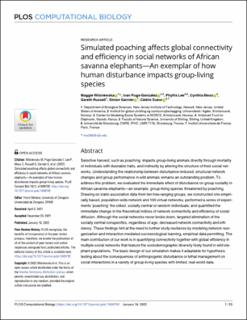| dc.contributor.author | Wiśniewska, Maggie | |
| dc.contributor.author | Puga-Gonzalez, Ivan | |
| dc.contributor.author | Lee, Phyllis | |
| dc.contributor.author | Moss, Cynthia | |
| dc.contributor.author | Russell, Gareth | |
| dc.contributor.author | Garnier, Simon | |
| dc.contributor.author | Sueur, Cédric | |
| dc.date.accessioned | 2022-06-24T10:55:26Z | |
| dc.date.available | 2022-06-24T10:55:26Z | |
| dc.date.created | 2022-05-12T10:03:53Z | |
| dc.date.issued | 2022 | |
| dc.identifier.citation | PLoS Computational Biology. 2022, 18 (1), . | en_US |
| dc.identifier.issn | 1553-734X | |
| dc.identifier.uri | https://hdl.handle.net/11250/3000572 | |
| dc.description.abstract | Selective harvest, such as poaching, impacts group-living animals directly through mortality of individuals with desirable traits, and indirectly by altering the structure of their social networks. Understanding the relationship between disturbance-induced, structural network changes and group performance in wild animals remains an outstanding problem. To address this problem, we evaluated the immediate effect of disturbance on group sociality in African savanna elephants—an example, group-living species threatened by poaching. Drawing on static association data from ten free-ranging groups, we constructed one empirically based, population-wide network and 100 virtual networks; performed a series of experiments ‘poaching’ the oldest, socially central or random individuals; and quantified the immediate change in the theoretical indices of network connectivity and efficiency of social diffusion. Although the social networks never broke down, targeted elimination of the socially central conspecifics, regardless of age, decreased network connectivity and efficiency. These findings hint at the need to further study resilience by modeling network reorganization and interaction-mediated socioecological learning, empirical data permitting. The main contribution of our work is in quantifying connectivity together with global efficiency in multiple social networks that feature the sociodemographic diversity likely found in wild elephant populations. The basic design of our simulation makes it adaptable for hypothesis testing about the consequences of anthropogenic disturbance or lethal management on social interactions in a variety of group-living species with limited, real-world data. | en_US |
| dc.language.iso | eng | en_US |
| dc.rights | Navngivelse 4.0 Internasjonal | * |
| dc.rights.uri | http://creativecommons.org/licenses/by/4.0/deed.no | * |
| dc.title | Simulated poaching affects global connectivity and efficiency in social networks of African savanna elephants-An exemplar of how human disturbance impacts group-living species | en_US |
| dc.title.alternative | Simulated poaching affects global connectivity and efficiency in social networks of African savanna elephants-An exemplar of how human disturbance impacts group-living species | en_US |
| dc.type | Peer reviewed | en_US |
| dc.type | Journal article | en_US |
| dc.rights.holder | © 2022 Wiśniewska et al. | en_US |
| dc.description.version | publishedVersion | en_US |
| cristin.ispublished | true | |
| cristin.fulltext | original | |
| cristin.qualitycode | 2 | |
| dc.identifier.doi | 10.1371/journal.pcbi.1009792 | |
| dc.identifier.cristin | 2023805 | |
| dc.source.journal | PLoS Computational Biology | en_US |
| dc.source.volume | 18 | en_US |
| dc.source.issue | 1 | en_US |
| dc.source.pagenumber | 23 | en_US |

